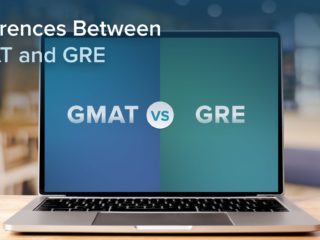| Getting your Trinity Audio player ready... |
Last Updated on May 15, 2023
Ratios appear in many word problems on GMAT quant, so a solid understanding of this topic is essential for a successful test day. This article will go over some of the fundamental characteristics of GMAT ratios and assist you in identifying and answering questions about part-to-part and part-to-whole ratios.
Here are the topics we’ll cover:
- What is a Ratio?
- What Information Does a Ratio Tell Us?
- Answering Ratio Questions
- Main Takeaways
- What’s Next?
To begin, we can answer the question, “What is a ratio?”
What is a Ratio?
A ratio is a relationship between two quantities. For example, if there are 5 blue markers and 6 red markers in a box, we can say that the ratio of blue markers to red markers is 5 to 6.
What if the box contained 10 blue markers and 12 red markers? In this case, the ratio of blue markers to red markers would be 10 to 12, but we could also say this ratio is equivalent to the original one, 5 to 6, because for every 5 blue markers in the box there are 6 red markers. We can see this by separating the markers into groups of 5 and 6 or by dividing both 10 and 12 by 2, much like we would when finding equivalent fractions. Therefore, even though there are more markers in the box, the ratio of blue markers to red markers is still 5 to 6.
KEY FACT:
A ratio compares two quantities.
We can express ratios in three equivalent ways. Using the previous example, we can express the ratio of blue markers to red markers as any of the following:
- blue markers to red markers = 5 to 6
- blue markers : red markers = 5 : 6
- (blue markers) / (red markers) = 5/6
While all three options above are perfectly fine to use, when solving the problems below, we will use the fraction notation (number 3 on our list).
What Information Does a Ratio Tell Us?
All ratios provide the following two pieces of information:
- how the parts of a ratio relate to each other
- how the parts of a ratio relate to the total of both parts.
Returning to the marker example, the ratio 5 to 6 that relates blue markers to red markers is an example of what is called a part-to-part ratio, because the blue and red markers are each part of the collection.
This same information can also be used to calculate what is called a part-to-whole ratio. We have a total of 11 markers in the box when there are 5 blue markers and 6 red markers. Thus, the ratio of blue markers to this total is the part-to-whole ratio 5 to 11, or 5/11. The ratio of red markers to the total, meanwhile, is the part-to-whole ratio 6 to 11, or 6/11.
KEY FACT:
A part-to-part ratio expresses a relationship between two parts, and a part-to-whole ratio expresses a relationship between a part and a whole. From any part-to-part ratio, we can work out the corresponding part-to-whole ratios.
Let’s practice with another example.
Example 1
In a class, the ratio of the number of students wearing pants to the number of students wearing shorts is 5 to 2. What is the part-to-part ratio of students wearing shorts to those wearing pants, and what is the part-to-whole ratio of students wearing shorts to total students in the class?
Solution:
To determine the part-to-part ratio of students wearing shorts to students wearing pants, we must flip the order of the given ratio, 5 to 2, because in that ratio, the 5 represents students wearing pants and the 2 represents students wearing shorts. Thus, the ratio of shorts to pants is:
shorts/pants = 2/5
Now, we can calculate a number to represent the total number of students in the class by adding the numbers representing the pants-wearing and shorts-wearing students. Thus, 5 + 2 = 7 represents the total. So, the part-to-whole ratio of students wearing shorts to students in total is:
shorts/total = 2/7
This part-to-whole ratio is valid regardless of how many students there are in the class. For example, if there are 5 students wearing pants and 2 students wearing shorts, then there are a total of 7 students in the class, and the ratio of shorts to total is 2 to 7. Or, if there are 15 students wearing pants in the class and 6 students wearing shorts, then the total number of students is 15 + 6 = 21, and so the ratio of shorts to total would be 6/21, which is also equivalent to 2/7.
What we did above can be turned into a general rule. If we have a part-to-part ratio x : y, then we can create the following part-to-whole ratios representing the same situation:
- x / (x + y)
- y / (x + y)
Answering Ratio Questions
Earlier in this article, we considered an example in which we had 11 markers in a box in which the ratio of blue to red markers was 5 to 6.
What if we were told that in another box, the ratio of blue markers to red markers was still 5 to 6, but there were 18 red markers in the box? In that case, could we determine the number of blue markers? Yes, we could!
Let’s let B equal the number of blue markers in this new box. Then, because we know that the ratio in the new box must still be equivalent to 5/6, we can set our old ratio equal to a new ratio in which we have B blue markers and 18 red markers.
(blue markers) / (red markers) = 5/6 = B/18
Note that when we set up the above equivalent ratios, we need to ensure they are both in the same order: blue to red. We now have an equation that we can use to solve for the value of B. We begin by cross multiplying:
(5)(18) = (6)(B)
90 = 6B
15 = B
There are 15 blue markers in the box.
Let’s practice with some more examples.
Example 2
At a convenience store, the ratio of bottles of iced tea to bottles of lemonade is 4 to 5. If there are 30 bottles of lemonade, then how many bottles of iced tea are there?
Solution:
From the problem stem, we see that the part-to-part ratio of bottles of iced tea to bottles of lemonade is 4 to 5. Next, since we are given that there are 30 bottles of lemonade, we can create the following equation in which T represents the number of bottles of iced tea.
T/30 = 4/5
Next, we cross multiply and solve this equation to determine T:
(T)(5) = (4)(30)
5T = 120
T = 24
There are 24 bottles of iced tea.
Example 3
If the ratio of blue jays to cardinals resting on a tree branch is 8 to 3, and if there are 33 blue jays and cardinals in total resting on the branch, then how many cardinals are resting on the branch?
Solution:
To start, we see that we have a part-to-part ratio of blue jays to cardinals that is equal to 8 to 3, with 8 representing the number of blue jays and 3 representing the number of cardinals.
However, we are then given the total number of blue jays and cardinals. Thus, we need to use the information from the part-to-part ratio to find a number representing the total number of birds. Doing so will allow us to determine the number of cardinals resting on the branch.
We can express the total number of blue jays and cardinals as 8 + 3 = 11, and so the part-to-whole ratio of cardinals to total is 3/11. We are also given that the total number of blue jays and cardinals is 33. Thus, we can let the number of cardinals = C and create the following equation:
C/33 = 3/11
Solving, we have:
(C)(11) = (3)(33)
11C = 99
C = 9
There are 9 cardinals resting on the tree branch.
Main Takeaways
This article has answered some of the questions that students most commonly ask regarding part-to-part and part-to-whole ratios.
We now know that all ratios provide the following two pieces of information:
- how the parts of a ratio relate to each other, called the part-to-part ratio
- how the parts of a ratio relate to the total of both parts, called the part-to-whole ratios.
We have learned how to calculate the part-to-whole ratio if we are given the part-to-part ratio, and how to calculate the part-to-part ratios if we are given the part-to-whole ratio.
What’s Next?
While we have provided a solid introduction to part-to-part and part-to-whole ratios here, we teach the topic of ratios in much greater detail in the Target Test Prep GMAT Course. So, if you’d like to continue your learning of ratios and get fully prepared for the GMAT, sign up for a full-access trial for just $1 to get started! If you would like some additional advice regarding GMAT quant, please read our article about how to improve your GMAT quant score.



